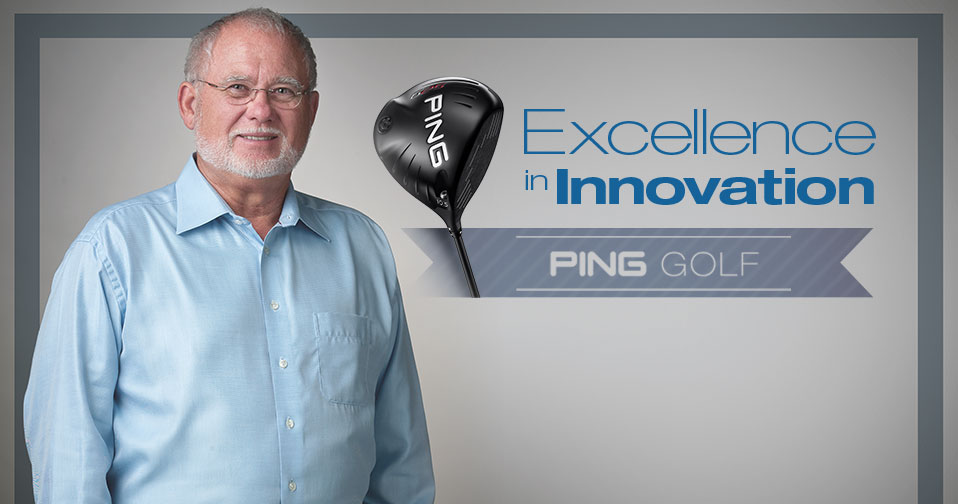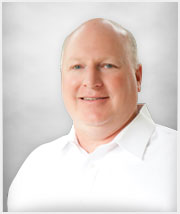Excellence in Innovation

As the ball dropped into the cup on the final hole of the 2014 Masters Tournament, an emotional Bubba Watson retrieved it and held it high to the roar of the gallery crowd. The youngest golfer in history to win two Masters within a three year span, this victory proved that his first Green Jacket was more than luck, although he is the first to deny the fact that he’s one of the greats of the game. Bubba’s humility, unabashed Christian character and drive to succeed are all traits that led PING Golf to become his leading sponsor and ambassador for the values that PING stands upon.
Bubba’s victory is yet another testimony to the company that has had more of an impact on the game of golf than any other; PING Golf. We had an opportunity to sit down with John Solheim, the Chairman and CEO of PING Golf to talk about the foundation of the company and how they continue to lead the industry while giving back to those in need. John is the second generation to lead the company along with his older siblings following in the footsteps of their father and founder, Karsten Solheim.
"Born the oldest son of parents from Norway, Karsten Solheim had to learn early in life how to overcome trials and struggles."
His mother passed away when he was two and a half years old while giving birth to his younger brother. His father was a self-taught craftsman and owned a shoe repair store. Karsten spent most of his free time helping his father run the shop. As he grew older, his father opened a second shop, which he ran while Karsten ran
the original shop.
Learning Business Skills for Life
Karsten learned business and management skills that would prove beneficial to him throughout his life. He also developed an uncanny ability to analyze broken shoes and devise methods to repair them as good as new, most times better than new. He and his father were known for their quality workmanship, for which people were willing to pay a premium.
Karsten’s faith had always been an integral part of his life. After high school, he became involved with leading his church youth group. While escorting the youth group to the church Christmas production, Karsten met a young woman, Louise, with whom he struck up a conversation. Louise had experienced similar heartache as a child, losing her mother shortly after her birth.
They had an instant connection in spite of their age difference; he was 24, and she was 17. After two weeks of dating, Karsten knew that she was the one that God had chosen for him and asked her to marry him. They were married six months later and had their first son, Karsten Louis (Louis). Karsten left the family business to pursue a career as a salesman, selling cookware, and soon rose to the top of the sales force.
Our Nation at War
It was during this time that the Japanese attacked Pearl Harbor, and America was thrust into World War II. There was a restriction placed on certain materials that were essential to producing goods for the military. Aluminum was one of those materials, the material used to make cookware that Karsten sold. With no new products to sell, Karsten was forced to seek other opportunities.
Karsten ran across an ad for a short, accelerated engineering course offered at the University of California-Fresno to help fulfill the military’s need for engineers. Karsten enrolled and excelled in the course. Halfway through, he was offered the opportunity to work for Convair (which later became General Dynamics) in their aircraft engineering division. From there, Karsten went to work for a shipyard and proceeded to develop numerous methods and designs to increase the rate of production and the quality of the ships.
In 1943 Karsten received papers to report for the military draft. Before leaving for the draft, he interviewed with the Ryan Aeronautical Company, makers of the military’s aircraft. After seeing Karsten’s resume and meeting him, they offered him a position in their engineering department utilizing his extraordinary engineering skills to advance the military’s war efforts.
The Consummate Engineer
Working alongside some of the finest engineering minds in the Nation, Karsten was immediately embraced and was quickly promoted to the chief mechanical engineer for the FR-1 Fireball, the Navy’s first fighter plane to utilize jet propulsion.
After the war, Karsten changed careers a few more times before landing a job with General Electric as a mechanical design engineer. Karsten moved to Ithaca, NY while Louise stayed in San Diego to raise their 3 boys, Karsten (Louis), Allan and John; and their daughter Sandra.
One day, Karsten was invited to join some colleagues after work for a round of golf. Although Karsten had a dusty set of clubs in his garage, he had never played before. He borrowed a set of clubs thinking that if he applied logic and physics, there was no reason why he shouldn’t be able to compete with the others in his group. He quickly found out that he had little or no control over where the little white ball would go once it left his club. As aggravating as it was on the fairways, it was even worse on the putting green.
Building a Better Putter
It fascinated Karsten that he could hit an acceptable drive and approach and even get the ball on the green in three or four strokes but would use almost that many more strokes attempting to putt the ball into the cup. He observed that the ball left the putter with no consistency at all, almost having a mind of its own. In fact, it bothered him immensely. So much so, that he immediately began to scientifically analyze the physics of the putter.
"He was convinced that he could design a better club to putt the ball with more consistency."
In 1953, Karsten was reunited with his family when they all moved to join him in Ithaca. Eighteen months later, General Electric transferred him to Syracuse, NY. In his spare time, Karsten continued to mull over his ideas for improving the putter. He realized that the key to getting the ball to respond consistently was the weight distribution in the head of the putter, referred to as heal-toe weighting. In the trials that he conducted in his home, he was encouraged by the results, even if it lacked aesthetic appeal.
Karsten was transferred once again, this time to California, where he began working on one of the first computerized banking programs for General Electric. He continued to work on his golf game, practicing every chance he got. He soon began competing in local tournaments and winning them with his unconventional putter. One day while playing on one of his favorite courses, he had a conversation with the local golf pro. The pro had commented on how impressed he was with Karsten’s putting. Karsten demonstrated his homemade putter, and the pro offered some advice. He told him that if he could design a club that would allow the ball to roll from the face of the club rather than skip or slide, as all of the current clubs of the day did, he would sell a million of them. This was the catalyst that Karsten needed.
The Musical Club
He reworked the design of his putter keeping the weight at the heel and toe of the head. When he had some of the new designs fabricated and tried them, they had a distinctive ring when they hit the ball; he referred to it as a “ping” and thought it would be a catchy name for the new club.
Karsten began manufacturing his new putter, the PING 1A, in his garage. His youngest child John, still in high school, and middle son Allan would help him assemble the clubs, while Louise managed the books and tracked the orders. Interest in the curious new putter picked up quickly as golfers saw immediate improvements to their games. In 1959, Sports Illustrated mentioned the “musical” new putter and orders started coming in immediately. One company ordered hundreds of them to give out as Christmas gifts.
Requests for the putter increased, and soon he was shipping out clubs from his garage. Karsten would visit golf courses across the country and demonstrate the new club to golfers and to the golf pros. As orders increased, he continued to refine the design of the club, releasing models 2A, 3A, 4A, 5A and 5B.
Still working for General Electric, Karsten was given the opportunity to transfer to their computer factory in Phoenix, Arizona. He jumped at the chance, since it would allow him to stay home much more and allow him to build his fledgling putter business. As business continued to grow, the Karsten Manufacturing Company was formed. In the mid-sixties, Karsten Manufacturing developed the most successful putter design in history, the Anser.
Changing the Game of Golf
Sales of the Anser putter were so successful that Karsten had to move production from his garage into a 2,200 square foot building in Phoenix, which would eventually grow to become the PING Golf campus. Karsten’s two other sons and daughter came to work for the company, and Karsten left General Electric to focus full time on his company.
As high profile players such as Jack Nicklaus, Gary Player, Gene Littler, Julius Boros and George Archer started using PING putters, orders kept pouring in. Karsten refused to mass-produce the clubs, insisting that each club was produced to order. Karsten began to focus on the other clubs in the set and developed an innovation for irons that used a cavity back club head called the Karsten 1, released in 1969.
Karsten Manufacturing, known today as PING Golf, employs more than 1300 and has changed the game of golf forever. It continues to be run as a family company with Karsten’s children and grandchildren involved in the business. Their innovations in club design including putters, irons and woods, allow average golfers to improve their scores and enjoyment for the game. The breakthroughs in design and manufacturing methods have been copied by almost all the top club makers, since the original patents have expired.
Succession of a Legend
In 1995, John Solheim took over as Chairman and CEO of PING. He had been a part of every stage of the company from its inception and shared the dogged pursuit of engineering excellence. Karsten passed away in 2000, but left behind a legacy of excellence and philanthropic devotion that John continues today. PING Golf has been instrumental in promoting LPGA events. In 1990, Karsten and Louise founded the prestigious Solheim Cup for women, the equivalent of the Ryder Cup for men. They have given millions of dollars to missionaries across the globe and funded state-of-the-art recreation centers at the Moody Bible Institute in Chicago and LeTourneau University in Longview, Texas called the Solheim Center. “I learned from my dad the importance of excellence and giving back and how that honors God,” John explained.
PING Golf has been a leader in aiding wounded veterans as well. They are corporate sponsors of the Wounded Warriors Project, Warfighter Sports and others. They have developed an Adaptive Fitting Program that provides specially designed golf equipment for golfers with special needs, allowing them to play and compete in events never before possible.
Never content with the status quo, John and his engineering team are constantly researching new designs, materials and manufacturing methods to improve the game of golf. John explains, “You never know where inspiration will come from.
It never ceases to amaze me how God places us in situations to reveal things to us as only He can. I recently visited Yellowstone National Park and saw a beautiful orange dragonfly. I had a high res camera with me and took some close-up photos of this brilliant creature that God designed. As I studied those photos later, zooming in on the wing structures, I was amazed at the wing structure, and it struck me that we can use a similar design in our clubs. We’re using some of that technology inside some of our new club designs.”
John recalls, “As a company, we weren’t immune from experiencing trials and tribulations. My father and I share the same source of inspiration from God and stand upon His word. One of his favorite verses, and one that I have come to understand and appreciate even more since taking over the company, is Proverbs 3:5-6:
"Trust in the Lord with all your heart, and lean not on your own understanding; in all your ways acknowledge Him, and He shall direct your paths.” Proverbs 3:5-6

By: Mark Whitaker
Mark Whitaker is the Executive Editor of TwoTen Magazine. He is inspired daily by his God, his wife Kim and his three daughters Hannah, Sarah, and Rhea.
Read More Articles by Mark Whitaker





